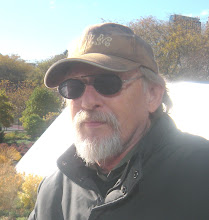While practicing the Sword Form in the mirrored room at my health center, I like to listen to music through earphones from my mp3 player. Although I am an advocate of “silent running,” so as to develop natural internal rhythms that match the movements of the form, I find it very helpful to have an auditory aid, especially when first learning. When I do the Yang Long Form, the empty handed one, I prefer a sort of drone--- a non-rhythmic sound, so that the speeds of the various movements can be even and flowing. But with the sword I find a variety of speeds more appropriate to what I suppose the applications of the Sword Form would be: slashing, chopping, slicing, thrusting, momentary pauses, turns and fanes.
I’ve been listening to cuts from an album by Bela Fleck called “Throw Down Your Heart, Tales from the Acoustic Planet, Vol. 3: African Sessions.” The sessions on this album were recorded by Fleck on a trip across Africa as he traced the origins of his chosen instrument, the banjo. In Uganda, Mali, Tanzania and South Africa, he played traditional African songs and jammed with local musicians using ethnic instruments like the thumb piano and xylophone. Included are kora master Toumani Diabate, guitarist D'Gary, vocalists Oumani Sangare and Baba Maal, ngoni player Baekou Kouyate, and djembe player Madou Sanogo. (This info is from comments by Scott Williams on the Amazon.com listing for the album.) There is a DVD documentary of the trip and a trailer for it on you tube: http://www.youtube.com/watch?v=WDCxaQhhL0A.
And one of the tracks from the album is at http://www.youtube.com/watch?v=iGrxfAdQDEI&feature=related.
Besides the musicological insights and virtuosity represented by Fleck and friends on the African album, what interests me is how well it overlays my sense of movement for the Sword Form. They call it “the Chinese Sword Dance,” probably because it looks so graceful and so energetic. The close rhythms and sharp percussive notes of the African music allow for subtle changes in momentum so that, unlike the constant flow of the empty hand form, there is a dynamic range of accelerating or slowing, an opportunity to energize a sweeping action of the arm-plus-sword from the toes up through the thigh muscles. (Actually, this all exists in the empty hand form as well; we just try to minimize the appearance of forcefulness ---to be soft.)
Another element of my sword practice has been the use of the tassel (attached to the pommel.) An improper increase in velocity or angle will definitely wrap the tassel around your wrist. While focusing on the sword in hand you become acutely aware of the location of that tassel. There are two small brass balls attached to my tassel which will clatter against the hilt of the sword in an abrupt maneuver or sudden stop. While it sounds kind of neat, it is another help toward learning how not to use the sword. As someone once told me, when you become a Tai Chi Master you can do it however you want. For now, study and practice ---and study and practice, and study and practice, and….
Friday, May 27, 2011
Tuesday, May 10, 2011
Allen Ginsberg, Tai Chi Poetry in Motion!
Many thanks to Amy Eisenberg of the Winged Lion School of Tai Chi in Erie, Pennsylvania, for the link to this poem reading and performance by Allen Ginsberg: Poetry Spot
There is a nice commentary about Ginsberg and the poem on the blog, The Allen Ginsberg Project.
And the text of the poem appears on .Acumedico.com.
I spent a little (read too little) time searching the internet for other poets that wrote about Tai Chi but to tell the truth, I was unimpressed by most of what I found. I think the Tai Chi Classics are themselves wonderful poetry that not only serves to define Tai Chi practice but also raise the spirit of the reader. Ginsberg's poem has a bit of tongue in cheek but does (for me) explore the difficulty of performing Tai Chi in a state of meditation. It's like the old joke about the alchemist who said the secret of turning lead into gold was to stir molten lead WITHOUT thinking of the word, "Hippopotamus."
There is a nice commentary about Ginsberg and the poem on the blog, The Allen Ginsberg Project.
And the text of the poem appears on .Acumedico.com.
I spent a little (read too little) time searching the internet for other poets that wrote about Tai Chi but to tell the truth, I was unimpressed by most of what I found. I think the Tai Chi Classics are themselves wonderful poetry that not only serves to define Tai Chi practice but also raise the spirit of the reader. Ginsberg's poem has a bit of tongue in cheek but does (for me) explore the difficulty of performing Tai Chi in a state of meditation. It's like the old joke about the alchemist who said the secret of turning lead into gold was to stir molten lead WITHOUT thinking of the word, "Hippopotamus."
Subscribe to:
Comments (Atom)



